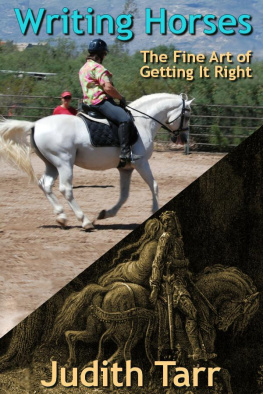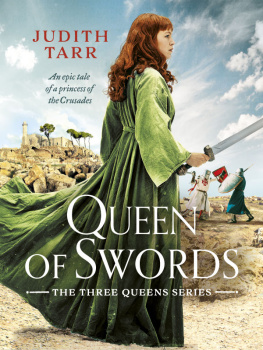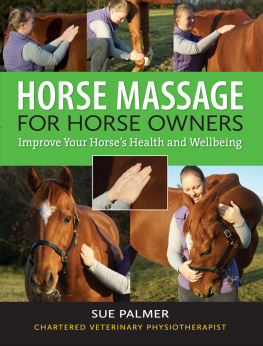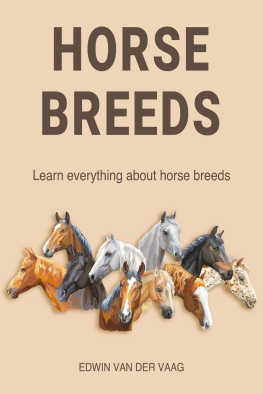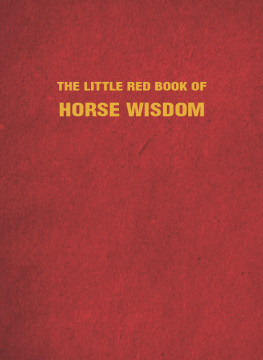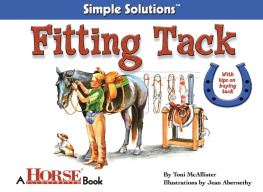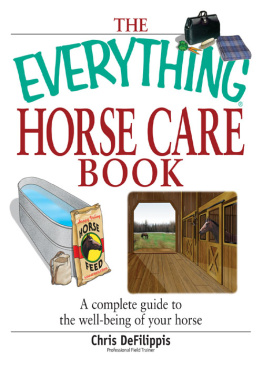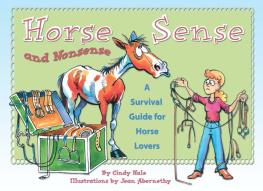Chapter 1
Horse-Training Basics for Writers:
Getting the Clothes on the Horse
One thing the non-horse person may not think about when writing about horses is that horses dont come out of the box saddled, bridled, trained, and ready to go. Even horse people who have ridden but never raised or trained a horse arent always aware that the process of getting the horse from zero to fully trained is a bit more involved than throwing tack on the horse and showing him a couple of cues: stop, go, left, right, WHOAAAA!
It is a process, and it starts with the unhandled, un-human-contaminated animalwhether newborn or older and feral off the range. People who have tamed and socialized Mustangs really know how much work it is to take this large, fast, instinctively reactive prey animal out of his herd and teach him to both respect and trust humans.
Breeders who raise foals have a much easier job, provided the foals dam is herself socialized and will tolerate humans near her baby. Its considerably less complicated to teach a baby to trust if babys mom is setting an example. Its also less physically taxing to deal with an animal who barely outweighs you, versus one in the half-ton or larger range.
Not that babies cant do some damage. Those half-dollar-sized hooves can hit like hammers, and once baby is up and steady on his feet, hes way faster than you are, and seriously strong. But still, hes nothing compared to what hell be when hes older.
The younger you teach a horse the rules of engagement with humans, the less trouble youll have when hes larger, older, and orders of magnitude stronger. With that in mind, lets look at a crucial part of the training experience: namely, getting stuff on the horse so you can lead him, drive him, or safely sit on him.
The first thing a breeder tries to do with a baby is get a halter on its head. This is absolutely basic in that when a horses head is under control, the rest of his body is quite a bit easier to manage.
A horse doesnt actually follow his nose. He pushes his back end toward the front. This is seriously nonintuitive for most humans. Were vertically oriented, our eyes point forward, and we do most of our major manipulation with our hands. But the horses head is relatively small, easily accessible, and loaded with sensory organsnot just the eyes and ears and nose but the whiskers and the organ inside the upper lip that enhances the sense of smell. Get some strappery around that and youve definitely got his attention.
Before you can do that, however, you have to catch him. This can be complicated by the fact that, sensibly for a prey animal, hes not wired to be caught. Even an older, trained horse may decide its not happening today. The reasons for this will range from hed rather finish his dinner, thank you, to the expectation that, once youve caught him, youre going to hurt him.
The trick is not to march up to him with intent to dominate. That sends the wrong message: Predator. Beware!
Sidle around. Dont look straight at him. Predators stare; herd and prey animals, stared at, will run. Stay calm and mellow. Move slowly, without fast movements or loud noises. In shortdont hunt him. Seduce him.
When he lets you near, dont go in straight on, to either the front or the rear. Head-on is aggression. Directly from behind is attackand youll very likely get kicked into the next county Move in toward his shoulder instead, where he can see you with that wide field of vision.
If you do that, youre signaling that you respect him. You want him to know youre there. Youre not a threat.
Now youre in his personal space, but dont get excited and leap or grab. Ease on up. If hes little, you can slide your arms around his body and hold him lightly around the chest and hindquarters. Then if he plunges or struggles, you can restrain him without losing him,
If hes larger, your best bet is to slide a soft rope around his neck and use give-take motions to stop him from taking off. He should have the prerequisite by this point, which is the concept of giving to pressure. If hes properly trained and youre properly calm and quiet with your body language, hell stand still for you.
Slide the halter quietly over his nose. If he flips up his head or backpedals, go with him as best you can, wait for him to ease up, then repeat your attempt.
I prefer a halter with a buckle up or rope tie near the ear, rather than one that requires me to pull the lot up from his nose over his ears. Horses react badly to things coming at their eyes from in front. Most interactions work better from the shoulder or neck forward.
To add to the challenge, horses can be weird about having their ears touched. Some will be shy about the area directly behind and between them as well. A halter that can be slipped up over the neck behind the ears, then slid over the nose and buckled near the ear without touching the ears or coming at the eyes, will defuse two common problems right therein adults as well as babies.
All of this requires some setup before it starts: acceptance of your touch, moving away from pressure rather than pushing into it, and not flipping out (or back or over) when the horse feels your hand or your equipment on his body. He has been desensitized, preferably gradually, to the point that when you put something on him, he doesnt regard it as a threat.
Now youve haltered him, and either hes been trained to lead or hes amenable to the concept. This is just the start.
Getting a halter on his head doesnt instantly mean hell tolerate anything else on his body. Each new piece of equipment needs its own course of desensitization. Saddle on the back? He has to learn not to try to shake or buck it off. Girth around the belly? Big issue with many horses. The undercarriage can be sensitive or ticklish, and cranking that girth tight can result in neck-shaking, snapping, kicking, body-slamming, and other ways of yelling, Get That Thing OFF Me!
The best weapon always is persistence. Also patience, agility in avoiding kicks and bites, and nerves of steel. Do it in installments. Watch the horse closely for signs of explosion. Know when to push and when to give it a rest.
Even putting clothes on a horse can be an adventure. A horse blanket can be a literal lifesaver in bad weather or with a horse who is ill or undernourished, to keep her warm and dry and protected from the elements. But the first time or two, before she realizes what its all about, getting ten yards of flapping fabric onto her back and quarters and around her chest can be an Adventure.
Ill start by haltering the horse. This tells her that its time to be obedient and to listen to what Im telling her.
Then I introduce her to the folded blanket. Ill let her see and sniff it. Ill touch her with it, slowly, reassuring her with my voice and body language.
She may shy or veer away from the strange, rustly object. I persist. When she calms down a bit, Ill drape it quietly over her neck and shoulders.
She may shy again. The blanket might fall off, which makes her even spookier. I keep my cool, and persist.
Gradually shell let me move the folded blanket down over her back. When it touches her hindquarters, especially if shes a young mare, she may get really unhappy.
I persist. No yelling or hitting or lunging at her. Just the same low level of This is happening, well take as long as we take, nobodys letting this become an ego battle or an emotional meltdown. Which can be Extremely difficult when its sleeting sideways and there are still six horses to be blanketed under the same awful conditions. But if I lose it even slightly, Ill lose her in a big way.
Slowly, by increments, I unfold the blanket until its covering her whole body. She may jump and spin. Ill follow her.
I have not, you may have noticed, tied her to anything throughout this process. Horses are world-class claustrophobes. The worst thing you can do to a horse who is already unhappy about a procedure is lock him on to something he cant get away from.

